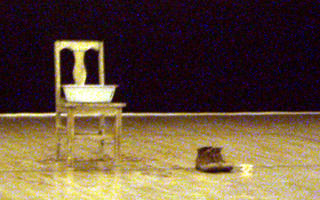Living with the dead...

“This thread thrown between your humanity and mine…” – Toni Morrison
I found it perplexing that the wonderful works of sculpture, interpretive dance and contemporary music displayed by Jen Berline, Robin Harris and Mark Scearce utilized death as the inspiration for creativity. It seems almost antithetical to take the death of a loved one as finite and complete as it might be and bring out such moving and vivid forms of expressions – of which span three different art forms. More often death is portrayed in art and music as something to be feared or approached with dread; however, these three artists managed to create endearing images and instill activity and life in the art they ultimately reshaped from grief, guilt, sorrow and sadness.
 Jen Berline turned her grief into an open process of transformation and renewal that was shared with her friends and family as well as the public audience. It is ironic that her final statue, completed during the fall season, seems to articulate the most vigor and sense of life when the time of year for the Fall Season is more the time of closing and slumber. She stated that “engaged in this activity, everything fell away…” that she connected in a hypnotic sort of way with her memories and her work. I found it very courageous that she not only extends her art for open criticism from the public (like any traditional artist) but openly/willingly shares what still seems like an extremely private and painful moment in her life.
Jen Berline turned her grief into an open process of transformation and renewal that was shared with her friends and family as well as the public audience. It is ironic that her final statue, completed during the fall season, seems to articulate the most vigor and sense of life when the time of year for the Fall Season is more the time of closing and slumber. She stated that “engaged in this activity, everything fell away…” that she connected in a hypnotic sort of way with her memories and her work. I found it very courageous that she not only extends her art for open criticism from the public (like any traditional artist) but openly/willingly shares what still seems like an extremely private and painful moment in her life.  Robin Harris, in a similar context, shared her childhood memories and her private thoughts this past week. Retelling stories about her ailing father as well as his journal entries from his childhood by integrating them through interpretative dance and visual storytelling. Although some of the steps and movements touched on the humorous one could still see how the allusions could draw you to a place in your life where you were surrounded by sadness, yet still understand it without letting it consume you.
Robin Harris, in a similar context, shared her childhood memories and her private thoughts this past week. Retelling stories about her ailing father as well as his journal entries from his childhood by integrating them through interpretative dance and visual storytelling. Although some of the steps and movements touched on the humorous one could still see how the allusions could draw you to a place in your life where you were surrounded by sadness, yet still understand it without letting it consume you.  Finally, using an entire orchestra, Mark Scearce painted a musical landscape of life and death based on the poem "The Dead of September 11" by Toni Morrison. The music “XL” reminded me of some of the works from John Williams, Holst: The Planets and “Danse Macabre”. It felt like “new age” crystals but evoked images of tapestry, thunder, strife and twists. It tasted like post apocalypse, Soylent Green, the saltiness from a bloody lip - Fight Club. I could see it used as a soundtrack to a film based on works from Hitchcock, Tolkien or Shakespeare. There were moments of twists, turns, agony, punched attacks, epic crescendos with layers of repeated silence between the notes. This music, like the other artistic forms of expressions mentioned earlier drew out a lot of movement and life which was created from the depths and finality of death.
Finally, using an entire orchestra, Mark Scearce painted a musical landscape of life and death based on the poem "The Dead of September 11" by Toni Morrison. The music “XL” reminded me of some of the works from John Williams, Holst: The Planets and “Danse Macabre”. It felt like “new age” crystals but evoked images of tapestry, thunder, strife and twists. It tasted like post apocalypse, Soylent Green, the saltiness from a bloody lip - Fight Club. I could see it used as a soundtrack to a film based on works from Hitchcock, Tolkien or Shakespeare. There were moments of twists, turns, agony, punched attacks, epic crescendos with layers of repeated silence between the notes. This music, like the other artistic forms of expressions mentioned earlier drew out a lot of movement and life which was created from the depths and finality of death.


